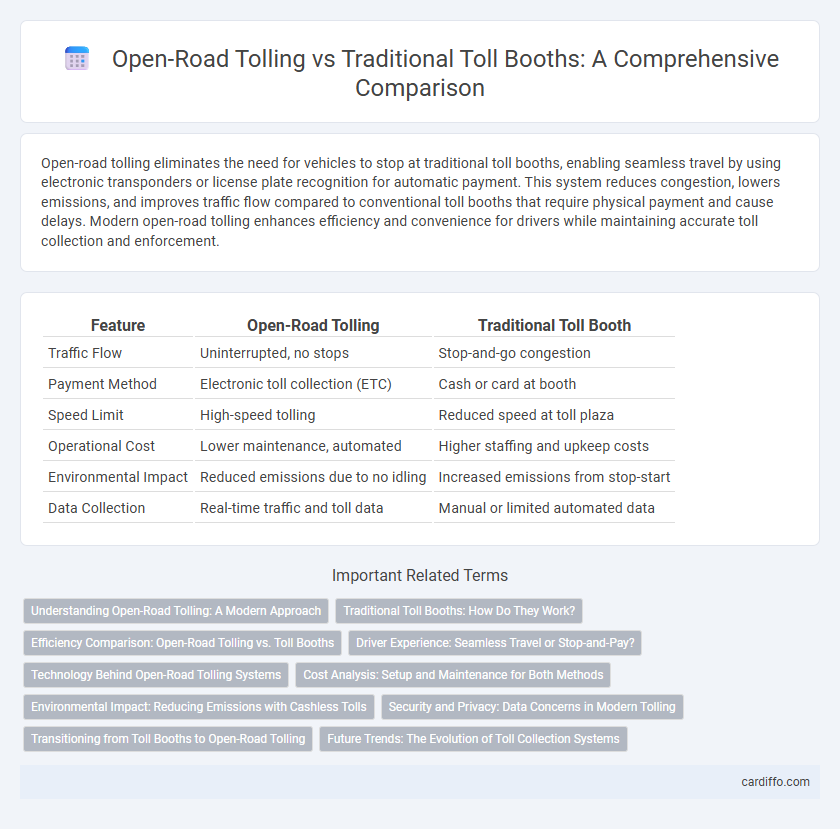Open-road tolling eliminates the need for vehicles to stop at traditional toll booths, enabling seamless travel by using electronic transponders or license plate recognition for automatic payment. This system reduces congestion, lowers emissions, and improves traffic flow compared to conventional toll booths that require physical payment and cause delays. Modern open-road tolling enhances efficiency and convenience for drivers while maintaining accurate toll collection and enforcement.
Table of Comparison
| Feature | Open-Road Tolling | Traditional Toll Booth |
|---|---|---|
| Traffic Flow | Uninterrupted, no stops | Stop-and-go congestion |
| Payment Method | Electronic toll collection (ETC) | Cash or card at booth |
| Speed Limit | High-speed tolling | Reduced speed at toll plaza |
| Operational Cost | Lower maintenance, automated | Higher staffing and upkeep costs |
| Environmental Impact | Reduced emissions due to no idling | Increased emissions from stop-start |
| Data Collection | Real-time traffic and toll data | Manual or limited automated data |
Understanding Open-Road Tolling: A Modern Approach
Open-road tolling eliminates the need for physical toll booths by using electronic systems to automatically charge vehicles as they pass under toll gantries, enhancing traffic flow and reducing congestion. This modern approach relies on RFID transponders or license plate recognition technology to seamlessly record toll transactions without stopping vehicles. By minimizing delays and vehicle emissions, open-road tolling significantly improves efficiency and environmental sustainability compared to traditional toll booths.
Traditional Toll Booths: How Do They Work?
Traditional toll booths operate by requiring drivers to stop or slow down at designated lanes where toll collectors or automated machines collect payments. These booths typically use cash, coins, or toll cards, with some incorporating electronic payment systems to expedite processing. The physical infrastructure often leads to congestion and delays due to manual transactions and limited throughput capacity.
Efficiency Comparison: Open-Road Tolling vs. Toll Booths
Open-road tolling significantly enhances traffic flow by eliminating the need for vehicles to stop, reducing congestion and travel time compared to traditional toll booths. Electronic toll collection systems in open-road tolling improve operational efficiency and decrease labor costs associated with manned toll plazas. Studies show open-road tolling can reduce vehicle emissions by up to 30% due to smoother traffic movement and less idling.
Driver Experience: Seamless Travel or Stop-and-Pay?
Open-road tolling eliminates the need for stopping by using electronic sensors that automatically charge drivers, creating a seamless travel experience with no interruptions to traffic flow. Traditional toll booths require drivers to stop and pay, causing delays, congestion, and increased fuel consumption. The enhanced convenience of open-road tolling improves driver satisfaction and reduces travel time significantly.
Technology Behind Open-Road Tolling Systems
Open-road tolling systems utilize advanced technologies such as RFID transponders, automatic license plate recognition (ALPR), and wireless communication to enable seamless vehicle identification and payment without requiring drivers to stop. These systems rely on high-speed cameras and sensors embedded in the road infrastructure to capture vehicle data accurately at highway speeds, significantly reducing traffic congestion. Unlike traditional toll booths that depend on manual toll collection, open-road tolling enhances efficiency and reduces operational costs through automated electronic toll collection platforms.
Cost Analysis: Setup and Maintenance for Both Methods
Open-road tolling requires significant investment in electronic toll collection infrastructure, including sensors, cameras, and backend systems, resulting in higher initial setup costs compared to traditional toll booths. Maintenance expenses for open-road tolling focus on software updates, equipment calibration, and data management, which tend to be lower over time due to reduced staffing needs. Traditional toll booths incur ongoing labor costs for toll collectors and physical booth upkeep, alongside expenses for payment processing hardware, which can accumulate significantly over the facility's operational lifespan.
Environmental Impact: Reducing Emissions with Cashless Tolls
Open-road tolling significantly reduces vehicle emissions compared to traditional toll booths by eliminating the need for vehicles to stop and idle during toll payment. This cashless system enables smooth traffic flow, decreasing fuel consumption and lowering greenhouse gas emissions. Studies show open-road tolling can cut emissions by up to 30% in high-traffic areas, promoting greener transportation infrastructure.
Security and Privacy: Data Concerns in Modern Tolling
Open-road tolling enhances security by minimizing physical contact and reducing cash handling risks compared to traditional toll booths, which are vulnerable to theft and data breaches. However, electronic toll collection systems raise privacy concerns due to continuous tracking of vehicle movements and storage of personal data. Implementing robust encryption protocols and strict data governance policies is essential to safeguard user information in modern tolling systems.
Transitioning from Toll Booths to Open-Road Tolling
Transitioning from traditional toll booths to open-road tolling (ORT) enhances traffic flow by eliminating physical barriers and enabling electronic toll collection at highway speeds. ORT systems use advanced technologies such as RFID transponders and automated license plate recognition to ensure accurate toll assessment without stopping vehicles. This shift reduces congestion, lowers operational costs, and improves overall road safety by minimizing accidents associated with toll booth stoppages.
Future Trends: The Evolution of Toll Collection Systems
Open-road tolling systems leverage advanced sensor technology and automatic license plate recognition to enable seamless, non-stop toll collection, significantly reducing traffic congestion compared to traditional toll booths. Future trends indicate widespread adoption of integrated digital payment platforms and real-time data analytics, enhancing efficiency and user experience. Increasing investment in Internet of Things (IoT) infrastructure and vehicle-to-infrastructure communication promises further evolution toward fully automated, dynamic toll pricing models.
Open-road tolling vs traditional toll booth Infographic

 cardiffo.com
cardiffo.com